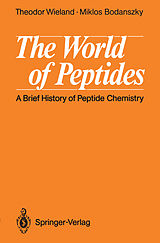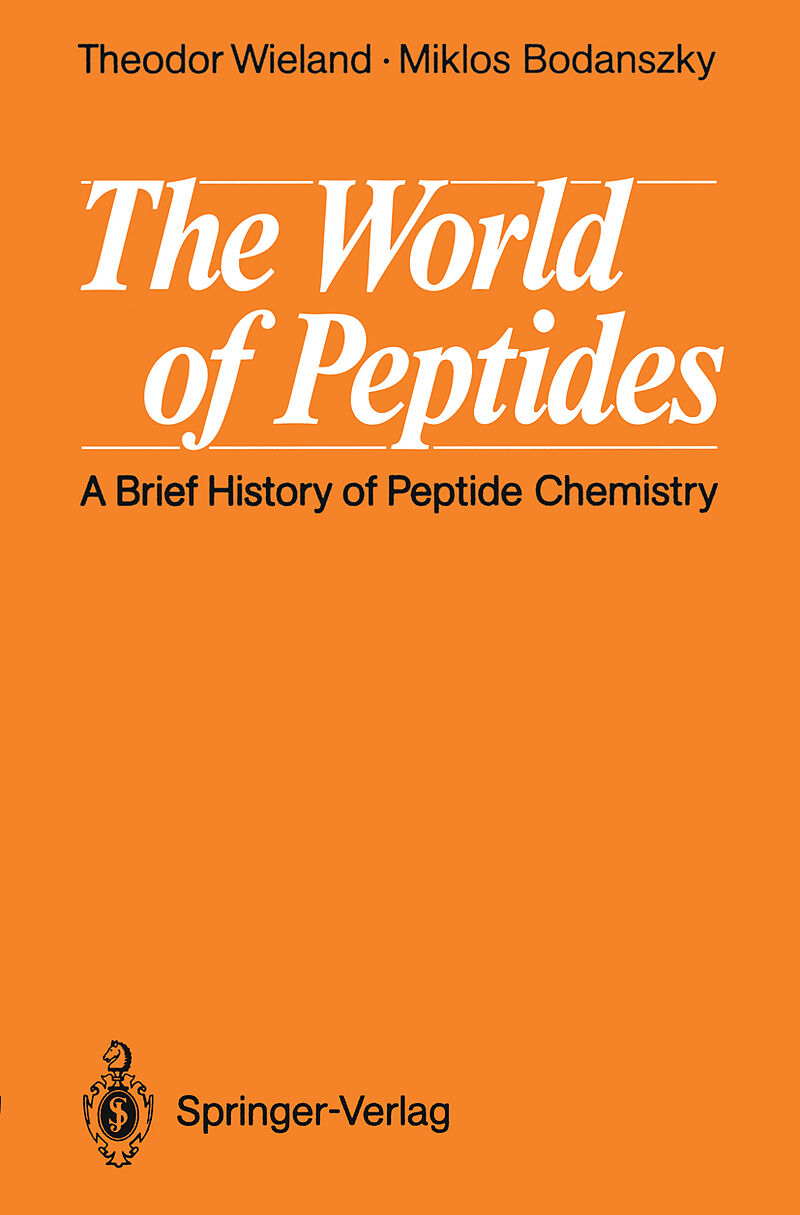The World of Peptides
Einband:
Kartonierter Einband
EAN:
9783642758522
Untertitel:
A Brief History of Peptide Chemistry
Autor:
Miklos Bodanszky, Theodor Wieland
Herausgeber:
Springer Berlin Heidelberg
Auflage:
Softcover reprint of the original 1st ed. 1991
Anzahl Seiten:
320
Erscheinungsdatum:
2011
ISBN:
3642758525
Almost two centuries ago proteins were recognized as the primary materials (proteios = primary) oflife, but the significance and wide role of peptides (from pepsis = digestion) in practically all life pro cesses has only become apparent in the last few decades. Biologi cally active peptides are now being discovered at rapid intervals in the brain and in other organs including the heart, in the skin of amphibians and many other tissues. Peptides and peptide-like compounds are found among toxins and antibiotics. It is unlikely that this process, an almost explosive broadening of the field, will come to a sudden halt. By now it is obvious that Nature has used the combination of a small to moderate number of amino acids to generate a great variety of agonists with specific and often highly sophisticated functions. Thus, peptide chemistry must be regarded as a discipline in its own right, a major branch of biochemistry, fairly separate from the chemistry of proteins. Because of the important role played by synthesis both in the study and in the practical preparation of peptides, their area can be considered as belonging to bio-organic chemistry as well. The already overwhelming and still increasing body of know ledge renders an account of the history of peptide chemistry more and more difficult. It appears therefore timely to look back, to take stock and to recall the important stages in the development of a new discipline.
Inhalt
1 Introduction. Amino Acids and a Few Early Paradigmatic Peptides.- 1.1 The Amino Acid Building Blocks of Proteins.- 1.2 Some Naturally Occurring Peptides.- 1.2.1 Glutathione, Structure and Biochemical Functions.- 1.2.2 Opthalmic Acid.- 1.2.3 Lycomarasmin, Malformin.- 1.2.4 Enniatins.- References.- 2 Syntheses of Peptides. The First Epoch.- 2.1 The Work of Theodor Curtius.- 2.2 Emil Fischer's Work.- 2.3 Fischer Against Curtius.- 2.4 The School of Emil Fischer in the Peptide Field.- 2.4.1 Emil Abderhalden.- 2.4.2 Hermann Leuchs.- 2.4.3 NCA-s and Polyamino Acids.- 2.4.4 Properties of Polyamino Acids.- References.- 3 The Era After Emil Fischer. The Carbobenzoxy Group, Max Bergmann and His Scientific Circle.- 3.1 Max Bergmann and the Rockefeller Institute.- 3.1.1 Chromatographic Separation of Amino Acid Mixtures.- 3.1.2 Peptides and Enzymes.- Enzymatic Peptide Synthesis.- 3.2 New Easily Removable Specific Protecting Groups.- 3.2.1 Acidolysis.- 3.2.2 Photolysis.- 3.2.3 Silico-Organic Compounds.- 3.2.4 Alkaline Reagents.- 3.2.5 Protection of the SH-Group.- References.- 4 A Second Breakthrough: New Methods for the Formation of the Peptide Bond.- 4.1 Anhydrides.- 4.2 Active Esters.- 4.3 Coupling Reagents.- 4.4 Side Reactions During Coupling.- References.- 5 A New Technology: Solid Phase Peptide Synthesis.- References.- 6 Structure Elucidation.- 6.1 Analysis of Amino Acid Sequences.- 6.1.1 End Group Determination.- 6.1.2 Stepwise Degradation.- 6.2 Spectroscopic Methods.- 6.2.1 Ultraviolet Absorption Spectroscopy.- Circular Dichroism.- 6.2.2 Vibrational Spectroscopy. Infrared Absorption. Raman Spectra.- 6.2.3 Nuclear Magnetic Resonance Spectroscopy (NMR).- 6.2.4 Electron Spin Resonance.- 6.2.5 Mass Spectroscopy.- 6.3 X-ray Crystallography.- References.- 7 Peptide Hormones.- 7.1 Oxytocin.- 7.1.1 Isolation.- 7.1.2 Structure.- 7.1.3 Synthesis.- 7.1.4 Studies of Relationships between Structure and Biological Activity.- 7.2 Vasopressins.- 7.3 Two Exponents.- 7.3.1 Vincent du Vigneaud.- 7.3.2 Josef Rudinger.- 7.4 Insulin.- 7.4.1 Discovery.- 7.4.2 Structure Elucidation.- 7.4.3 Synthesis.- 7.5 Corticotropin.- 7.6 Gastrointestinal Hormones.- 7.6.1 Gastrin and Cholecystokinin.- 7.6.2 The Secretin Family.- 7.6.3 Motilin.- 7.6.4 Galanin.- 7.7 Parathyroid Hormone and Calcitonin.- 7.7.1 Parathyroid Hormone (PTH).- 7.7.2 Calcitonin.- 7.8 Somatostatin.- 7.9 Releasing Hormones (Releasing Factors).- References.- 8 Biologically Active Fragments of Proteins.- 8.1 Angiotensin.- 8.2 Bradykinin and Kallidin.- 8.3 Substance P.- 8.4 Biologically Active Peptides from Mollusks, Frogs, Toads, Snakes and Insects.- 8.4.1 Eledoisin.- 8.4.2 Physalaemin and Other Peptides from the Skin of Amphibians.- 8.4.3 Venom Peptides.- 8.5 Opioid Peptides.- 8.6 An Era of Discoveries.- References.- 9 Biologically Active Peptides from Microorganisms and Fungi.- 9.1 Ergot Alkaloids.- 9.1.1 Cyclols.- 9.2 Peptide Antibiotics.- 9.2.1 Penicillins and Cephalosporins.- 9.2.2 Valinomycin.- 9.2.3 Gramicidins.- Cyclization of Linear Peptides.- 9.2.4 Alamethicin.- 9.2.5 Cyclosporin A.- 9.3 The Peptides of Amanita Mushrooms.- 9.3.1 Antamanide.- 9.3.2 Poisonous Peptides from Amanita Mushrooms.- Phallotoxins and Virotoxins.- Actin.- The Amatoxins.- Toxicity.- 9.4 Microcystins.- 9.5 Lantibiotics.- 9.6 Peptides Interacting with Nucleic Acids.- References.- 10 Peptide Research Around the World.- 10.1 Australia.- 10.2 Austria.- 10.3 Belgium.- 10.4 Bulgaria.- 10.5 Canada.- 10.6 China.- 10.7 Czechoslovakia.- 10.8 Denmark.- 10.9 France.- 10.10 Germany.- 10.11 Greece.- 10.12 Hungary.- 10.13 India.- 10.14 Israel.- 10.15 Italy.- 10.16 Japan.- 10.17 New Zealand.- 10.18 Norway.- 10.19 Poland.- 10.20 Portugal.- 10.21 Spain.- 10.22 Sweden.- 10.23 Switzerland.- 10.24 The Netherlands.- 10.25 United Kingdom.- 10.26 USA.- 10.27 USSR.- Author Index.

Leider konnten wir für diesen Artikel keine Preise ermitteln ...
billigbuch.ch sucht jetzt für Sie die besten Angebote ...
Die aktuellen Verkaufspreise von 6 Onlineshops werden in Realtime abgefragt.
Sie können das gewünschte Produkt anschliessend direkt beim Anbieter Ihrer Wahl bestellen.
Loading...
Die aktuellen Verkaufspreise von 6 Onlineshops werden in Realtime abgefragt.
Sie können das gewünschte Produkt anschliessend direkt beim Anbieter Ihrer Wahl bestellen.
| # | Onlineshop | Preis CHF | Versand CHF | Total CHF | ||
|---|---|---|---|---|---|---|
| 1 | Seller | 0.00 | 0.00 | 0.00 |
